disney tree of life animal kingdom line drawing

Cinderella Castle, Spaceship Earth, Earful Tower and now Mickey's Sorcerer's Hat — all of these structures have one thing in common. These are the icons that represent the various Walt Disney World theme parks.
The word "icon" has its roots in early Eastern Christianity. Icon-paintings of the time depicted a holy object or being such as the cross, Jesus, Mary, angels, and saints. The mere sight of one of these paintings, or icons, would instill a feeling of spirituality within an individual.
As the centuries marched on, the meaning of the word icon was expanded. Today, an icon can be a two or three dimensional likeness that represents an object, idea, or place by virtue of a resemblance or analogy to it. Or it can be an actual object that represents a greater whole. Marketing firms know this well and use icons to sell their goods and products. Beginning in 1955, this sight of Sleeping Beauty Castle, the icon of Disneyland, made us long to visit the Happiest Place on Earth.

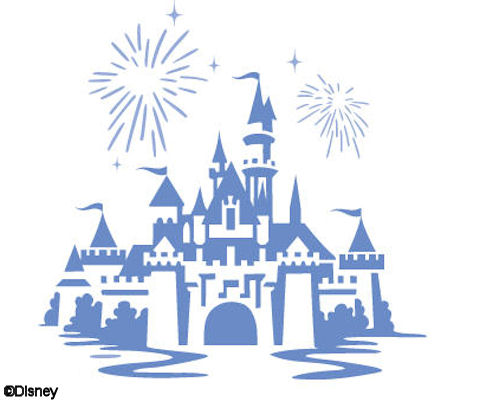

When the Imagineers began thinking about Disney's Animal Kingdom in 1989, they knew this new park would also need an icon to represent it to the world. But what would this be?
The Tree of Life was the answer. This icon would impart the message of the Animal Kingdom with a single glance. A gigantic tree would represent the abundant plant life of the planet and the many creatures that would be carved into its bark would symbolize the vast array of animals that call Earth home. However, the Tree of Life did not start out as the mighty structure that it would eventually become. Early designs called for a tree about 50 feet high that would act as a playground for children. As ideas for the tree began to evolve and grow, a viewing platform was envisioned within its branches where guests could survey Safari Village (now Discovery Island) and the environs beyond.
In this early concept drawing, you can see people climbing up into the Tree of Life (right side of the picture).
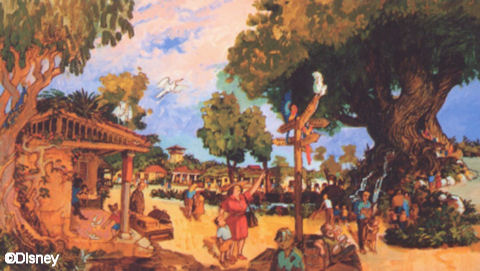
As the tree continued to grow in concept, so did the Imagineers' ideas. One early plan called for a fine eatery to be housed beneath the tree and called Roots Restaurant. But this idea was eventually abandoned in favor of a theatrical show. However, placing a restaurant or a theater beneath such a large structure would create engineering problems. The tree needed to withstand hurricane force winds and a large room built directly under the tree's trunk would make constructing a proper foundation difficult. The idea for the Tree of Life came to a standstill until a solution could be found.
An answer to the problem came from one of the Imagineers who was home watching an educational television program about off-shore oil drilling in the Gulf of Mexico. Upon seeing the type of structure used in this endeavor, he knew immediately that the Tree of Life could move forward. The free-span oil-drilling platform offered a wide base, large enough to house a good-sized room, a narrow center section for the tree's trunk, and an expanding top section capable of supporting branches. After preliminary studies were made, a drilling platform was purchased and shipped to Tampa. From there it was trucked to the Animal Kingdom and erected onsite. This next picture shows a model of the structure.
(I received a comment from a reader who tells a slightly different story about the origins of the Tree of Life. Please see John Katok's comment below.)

The next problem to tackle would be the branches. In order to withstand winds in excess of 74 miles an hour, it was believed that the limbs would need to be made out of a rigid, non-flexible material, like steel. In addition, in order to make the project cost effective, the branches would need to be mass produced. This would dictate that limbs of equal size be of identical shape. However, uniformity is not found in nature. When wire-frame drawings and artist renderings were completed, the tree resembled an inflexible geodesic dome more than a glorious tree.

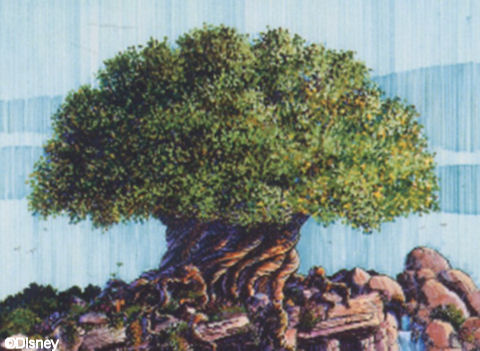
To solve these problems, the Imagineers first developed a flexible, injection-molded fiberglass to create the branches. These would range in size from 2-feet in circumference at the trunk of the tree to 2 inches where the leaves would attach at the end. And since the material was flexible, the limbs would move in the wind, just like a real tree.
Next, a way to attach identical branches in a random pattern was needed. To resolve this problem, 32 balls were created and secured to the tree. From each ball, one or two secondary branches could be attached in various positions. Special expansion joints allow the secondary limbs to move when a breeze passes through. From these branches, smaller, tertiary boughs could be attached, twisted and turned to create a natural shape. In some cases, branches would be omitted from a "standard" socket, in an effort to create a more chaotic appearance. When completed, the Tree of Life had 12 primary branches, 45 secondary branches, 756 tertiary branches, and 7,891 end branches. The tree stands 145 feet tall and is 165 feet across.

It's interesting to note, the final design and shape of the Tree of Life was based on a specific bonsai tree the Imagineers discovered at an early Epcot International Flower & Garden Festival. I don't know if this following picture, taken at this year's event, is the same tree, but it certainly reminds me of the Tree of Life.

This next picture shows rows and rows of identical limbs that would eventually take on a natural design.
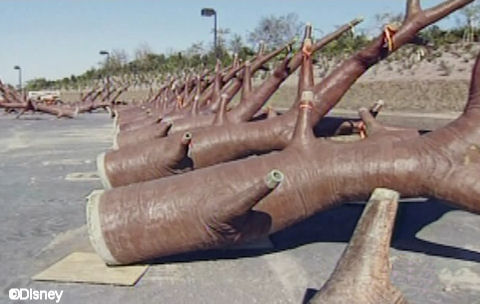
The Imagineers worked with outside firms to develop a natural looking leaf that would withstand wind, heat, cold, and moisture. In addition, the leaves could not be allowed to fade in the sun so they also needed to resist the effects of ultraviolet light. In the end, 102,583 leaves, each over a foot long, were created and attached to the Tree of Life. They come in five shades of green and they too rustle in the wind.
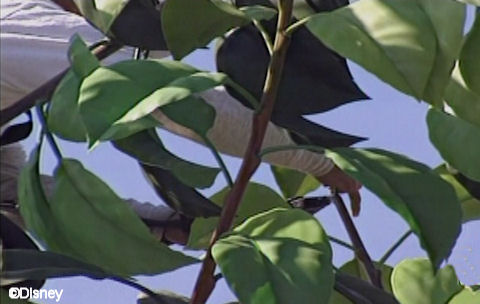
The branches and leaves were assembled on the ground and then lifted by crane into place.

Of course, the real fascination of the Tree of Life is not the tree, but the over 320 animals that are carved into its trunk. To create this work of art, an international team of artists was assembled. Those not already a part of the Disney team all had their own studios and had proven themselves in various media in advance of the project.
The tree's skin began as a half-inch to the foot model that featured no animals. This model only duplicated a rough approximation of what the Imagineers wanted to recreate in real life. The model was then cut into 4″x4″ sections. Each section was then scored in 1 inch intervals. A stylus was run along the scoring and the information recorded into a computer. This data was next sent to a rebar-bending machine that recreated the shape in actual size. Finally, the rebar was attached, piece by piece, to the trunk of the tree and welded into place. The attachment of the rebar took 12 weeks to complete.
Next, the rebar was covered with metal lath, a chicken-wire type material. This would act as a skin to which concrete would be applied. Both the metal lath and the initial coat of concrete can be seen in this next picture.

Scaffolding, approximately six feet wide, circled the tree on multiple levels. This would provide the artists with a place to work their magic. The animals were carved out of a special plaster-like cement that was applied at a depth of 2 to 4 inches over the first layer of concrete. The artists worked from the top down and each could complete approximately a 6 to 8 square foot area within the 6 to 7 hours the concrete was soft enough to sculpt. This would equate to roughly one average sized animal.


Coloring and texture was also a consideration. Various shades of browns and greens were used to create shadows and depth. When the painting was done, a final coat of polyurethane was added to shield the figures from harmful ultraviolet rays which would fade the paint.
For texture, three types of tree bark were emulated when creating the various animals: banyan, oak, and cedar. Samples of each were kept nearby for the artists to study. For example, the stripes on the tiger resemble banyan bark while the octopus' skin is modeled on oak.
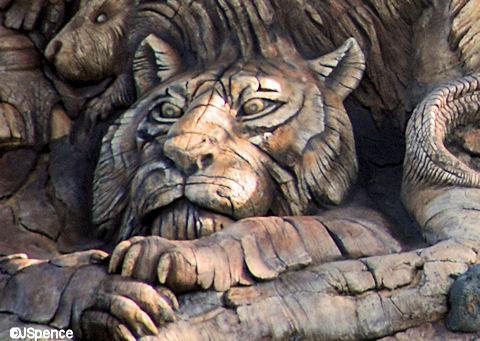
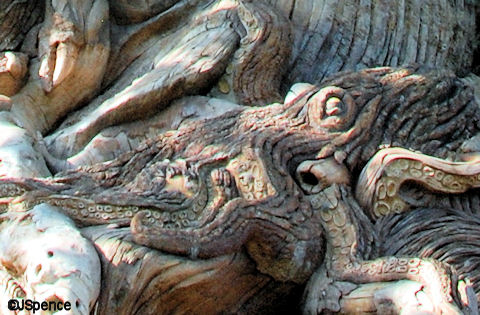
No particular scale was used when adding the animals to the tree. For example, in this next picture we see an ant as large as an ape's face. Yet despite the disregard to size, the animals all seem to blend together seamlessly.
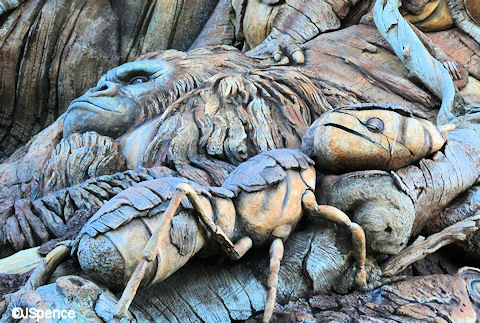
It took a team of ten artists and three Imagineers working full-time for 12 months to complete the carvings. In all, the Tree of Life took over two years from the beginning of construction to its finished beauty.
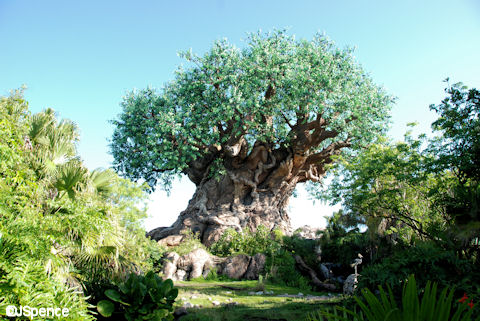
Now that I've given you the real story of the Tree of Life, let me give you the Disney Legend — a story to tell those who want to believe in the magic.
Once upon a time, no vegetation would grow on Discovery Island. There were no trees, no shrubs, no flowers, nothing. It was a barren piece of land. Then, one day, a tiny ant planted a seed and made a wish. He asked for a tree to grow — a tree large enough to provide shelter for all the animals. Magically, the ant's wish came true and a tree began to grow — and it kept growing until there was room beneath its limbs for all the animals from A (ants) to Z (zebras). And as the tree continued to reach for the heavens, the images of all the animals that took shelter beneath its shade appeared on its trunk, roots, and branches.
The Tree of Life is a magnificent structure. I never tire of looking at it. And to show what a fantastic job the Imagineers did at creating this work of art, I recently heard a teenage girl ask her parents if the tree was real (alive). Although I chuckled to myself when hearing this question, the girl's inquiry was sincere. What better complement could someone pay the artists who created this icon for the Animal Kingdom?
Next week I'll discuss the "It's Tough to be a Bug" attraction that lies within the roots of the Tree of Life.
Source: https://allears.net/2012/06/04/tree-of-life-at-disneys-animal-kingdom/
0 Response to "disney tree of life animal kingdom line drawing"
Post a Comment